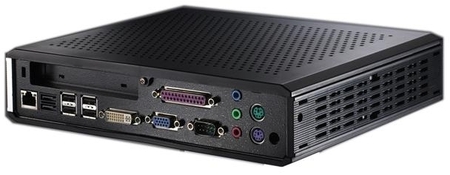First dual-monitor LTSP 5 set-up?
Oct 9, 2008 — by LinuxDevices Staff — from the LinuxDevices Archive — 51 views DisklessWorkstations says one of its thin clients now supports dual monitors, when used with LTSP 5 (Linux Terminal Server Project v5). The Troy, Michigan based thin client vendor claims to be the “first to release how to configure dual monitors using LTSP 5.”
DisklessWorkstations says one of its thin clients now supports dual monitors, when used with LTSP 5 (Linux Terminal Server Project v5). The Troy, Michigan based thin client vendor claims to be the “first to release how to configure dual monitors using LTSP 5.”
Given that… DisklessWorkstation's 1400 series terminals are based on Via's Eden processor, which is pervasive among thin clients, the company's instructions may also work on thin clients from other vendors. For those in a hurry to try, the documentation can be downloaded here without registration.
A bit of LTSP background
DisklessWorkstations calls itself the “global leader in LTSP based, thin-client hardware, strategy, and deployment.” It is headed up by Ron Colcernian, who along with Jim McQuillan, has arguably been one of the LTSP project's leading lights.
LTSP software enables dozens of graphical X terminals to run Linux desktops served up by a single Linux server. Touted benefits of the architecture, compared to separate PCs, include much better energy efficiency and reliability, and lower equipment and maintenance costs.
Once difficult to set up and configure, LTSP has in recent releases moved to a nifty dual-filesystem architecture, with the filesystem for the clients installed separately in /opt. This makes it trivial to chroot in and administer the client environment just like any other Linux system, yet separately from the server filesystem. After the filesystem is updated, a script is run to generate a squashfs filesystem image for use by LTSP clients on the network.
However, LTSP software still has one major weakpoint. Though generally considered adequate for use in schools, cafes, libraries, and other modest-sized computing networks, LTSP does not scale as well as enterprise thin client technologies like Citrix or RDP. Ditto that for the newest crop of thin client “virtualization” products, which typically use these same Citrix or RDP protocols to achieve greater scalability than can LTSP. This picture may change if and when LTSP gets adapted to work with open source differential compression technologies like NoMachine's NX.
Other weakpoints for LTSP have traditionally been:
- Lack of support for dynamically loaded modules — say to transparently support USB peripherals
- Poor performance and network scalability issues with multimedia streaming
- Lack of support for dual monitors
Diskless Workstations says it is the first to solve the dual-monitor problem, or at least the first to publish instructions for doing so with LTSP 5. Its instructions use its 1400 Series Thin clients by way of example, but may work with similar Via-based thin clients, of which there are many.
The 1420 PXE and 1425 Etherboot
The 1400 devices are based on 1.2GHz Eden processors with integrated Unichrome graphics processors. They support DDR2 RAM, and not surprisingly given the network demands dual monitors could impose, sport gigabit Ethernet interfaces.

The 1400 bristles with I/O and expansion possibilities
(Click to enlarge)
The 1400 clients appear to offer both legacy and USB-based input device connectors, along with a full range of PC I/O. It would appear that PCI expansion is also possible (see photo above), though the company does not tout this option. It does say that with its parallel port, serial port, and numerous USB ports, the device can support local printers, barcode scanners, and USB CD-ROMs.
The 1400 series clients are offered by DisklessWorkstations preinstalled with embedded Linux, or without an OS in separate PXE and Ethernet versions for use with LTSP. The devices also support Windows CE and XP Embedded, according to the company.
Erick Tyack, CTO, commented, “Dual monitors are vital to workplace productivity and efficiency!”
John Hansknecht, director of technology at the University of Detroit Jesuit High School and Academy, stated, “Deployed in 2003, with high customization, no licensing cost, and long server up-times, LTSP has proven to be the superior thin client software package for our highly demanding school environment.”
Availability
The 1400 series clients, including the 1420 PXE and 1425 Etherboot, are available now from DisklessWorkstations, priced at $313 and $325, respectively. Volume discounts may be available.
DisklessWorkstation's instructions for dual-headed monitors can be downloaded freely, without registration, here.
This article was originally published on LinuxDevices.com and has been donated to the open source community by QuinStreet Inc. Please visit LinuxToday.com for up-to-date news and articles about Linux and open source.